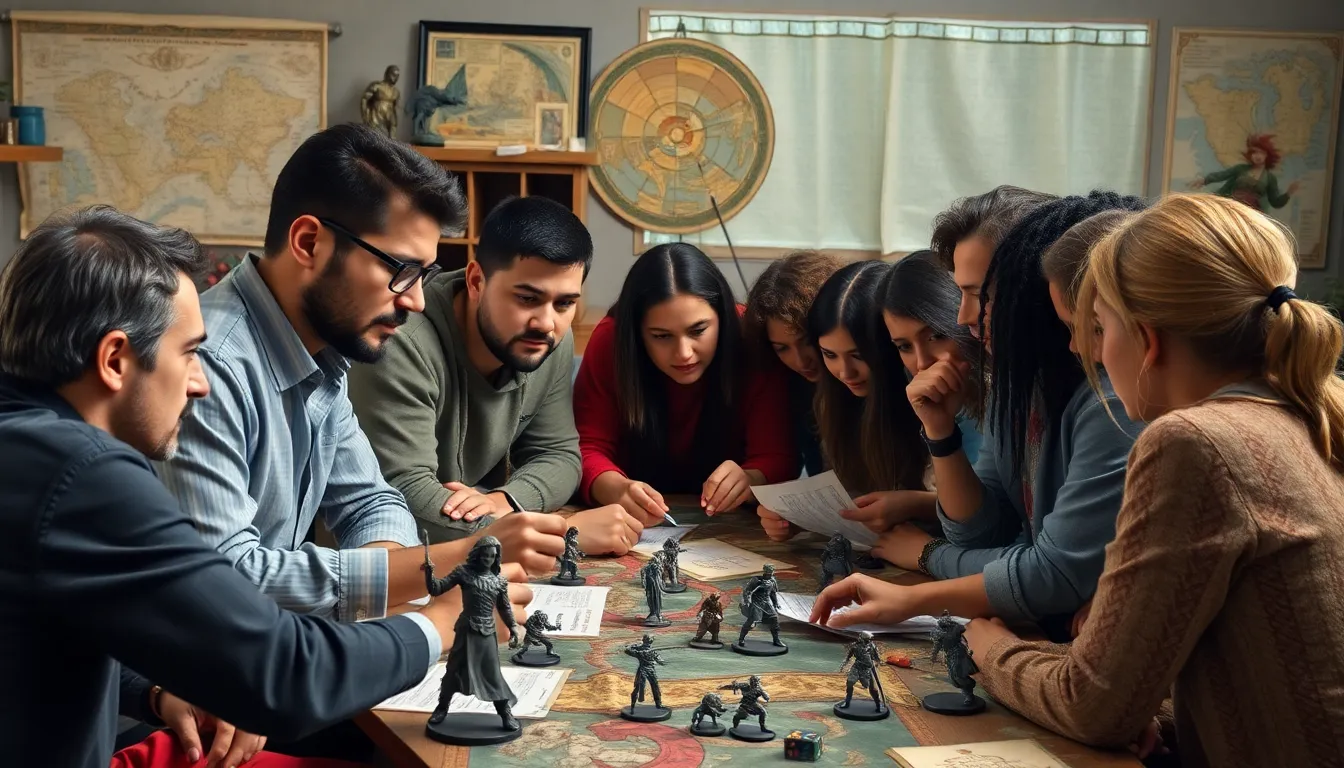In the vibrant world of gaming, few genres spark creativity and imagination quite like role-playing games (RPGs). These immersive experiences allow players to step into the shoes of unique characters, navigating rich narratives and making impactful choices. Behind every captivating RPG lies a complex design process that blends storytelling, mechanics, and player engagement.
Designing a successful RPG requires more than just crafting an intriguing plot. It involves understanding player psychology, balancing game mechanics, and creating a world that feels alive. As the popularity of RPGs continues to soar, aspiring designers are eager to learn the secrets behind creating unforgettable gaming experiences. This exploration into role-playing game design will uncover essential elements and innovative techniques that can transform an idea into a beloved game.
Table of Contents
ToggleOverview of Role-Playing Game Design
Role-playing game design encompasses various elements that contribute to creating immersive experiences. Designers focus on storytelling, character development, and game mechanics to engage players.
Core Elements of RPG Design
- Storytelling: Compelling narratives include intricate plots that captivate players’ interests. Well-crafted stories allow for emotional investment and player agency.
- Character Development: Multifaceted characters enrich gameplay. Designers must create backstories, motivations, and relationships that resonate with players.
- Game Mechanics: Balanced mechanics ensure fair play while promoting excitement. Designers integrate rules governing actions, conflict resolution, and character progression.
- World Building: Detailed settings enhance immersion. Environments should include geography, culture, and history, making the game world feel alive.
- Player Engagement: Engaging players involves understanding their preferences and motivations. Feedback loops, rewards, and challenges keep them invested.
Design Approaches
- Narrative-Driven Design: Prioritizes storytelling while shaping gameplay around plot developments.
- Mechanics-Focused Design: Emphasizes innovative game mechanics driving the player’s experience.
- Hybrid Approaches: Combines storytelling and mechanics to create unique and adaptable gameplay.
Current Trends in RPG Design
- Dynamic Storytelling: Incorporates player choices affecting narrative outcomes. This creates unique experiences for each gameplay session.
- Multiplayer Experiences: Multiplayer options enhance cooperation and competition, fostering community engagement.
- Inclusive Design: A focus on diversity and representation makes games accessible to a broader audience, enriching the player experience.
Conclusion of Overview
This overview highlights the essential components and strategies for effective RPG design. Understanding these elements contributes significantly to crafting engaging and memorable gaming experiences.
Core Elements of Role-Playing Games

Role-playing games encompass several core elements that shape the player experience. Understanding these elements is crucial for effective RPG design.
Game Mechanics
Game mechanics define the rules and systems that govern gameplay. Mechanics include combat rules, skill checks, and resource management. They ensure a balanced challenge and foster engagement.
- Combat System: Defines how players engage in battles, impacting strategic decisions.
- Progression: Involves leveling up characters through experience points and skill acquisition.
- Resource Management: Includes tracking inventory, currency, and character health, adding layers of strategy.
- Conflict Resolution: Encompasses dice rolls or cards that determine outcomes, reinforcing unpredictability.
Effective game mechanics contribute to a rewarding gaming experience, motivating players to explore and invest time in the RPG.
Storytelling Techniques
Storytelling techniques shape the narrative of role-playing games. Strong narratives captivate players and enhance immersion.
- Character Arcs: Display character growth and development, allowing players to relate to their journeys.
- Narrative Pacing: Controls the flow of the story, balancing action with exposition to maintain engagement.
- Worldbuilding: Creates a rich backdrop for the story, establishing lore, cultures, and histories that resonate.
- Dialogue Choices: Provides branching conversations, allowing players to influence outcomes and engage with the plot.
Robust storytelling techniques enable players to forge emotional connections, enhancing their overall gaming experience.
Player Engagement Strategies
Player engagement strategies play a crucial role in the effectiveness of RPG design. They focus on deepening the player’s connection to the game and enhancing overall enjoyment.
Character Development
Character development serves as a primary driver of player engagement. Designers create compelling characters with distinct personalities, backgrounds, and motivations. Engaging players in character arcs facilitates emotional investment in the story.
- Customization: Allowing players to tailor their characters’ appearances and abilities fosters a personal connection.
- Relatable Traits: Incorporating traits that resonate with players, such as flaws or strengths, enhances identification with the character.
- Growth Arcs: Designing clear development paths for characters encourages players to invest time and effort in their growth within the game.
World-Building
World-building establishes a vibrant setting that captures player interest and immerses them in the game. A well-crafted world enhances player exploration and interaction.
- Lore Creation: Developing extensive histories, cultures, and conflicts within the game world adds depth and context, making the environment feel alive.
- Dynamic Environments: Implementing responsive settings that change based on player actions keeps engagement high and encourages exploration.
- Interactive Elements: Including characters, quests, and artifacts that players can interact with enriches the gaming experience and promotes active participation.
Balancing Gameplay and Narrative
Balancing gameplay and narrative is crucial for creating an engaging role-playing game (RPG) experience. Successful RPGs harmonize these two elements, ensuring that neither overshadows the other. A well-crafted narrative draws players into a world, while balanced gameplay keeps them actively participating.
Mechanics-Driven Enhancements
Mechanics-driven enhancements focus on integrating narrative elements into game systems. Designers can implement mechanics that reinforce story themes, providing context to player choices. For example, in-game actions that reflect character motivations enhance immersion. Unique skills or spells tied to personal backstories deepen the connection between character development and gameplay.
Storytelling Techniques
Storytelling techniques play a vital role in shaping player experiences. Incorporating diverse narrative paths allows players to influence the outcome of the story. Non-linear narratives and branching quests foster a sense of agency, encouraging exploration. Implementing well-structured dialogue trees gives players the ability to shape character relationships, impacting the overall narrative arc.
Emotional Engagement
Emotional engagement thrives when gameplay aligns with narrative progression. Players become more invested in characters through relatable struggles and triumphs. Incorporating challenges that mirror character growth facilitates emotional connections. When players feel their decisions shape the narrative, it enhances their commitment to the game world.
World-building Synergy
World-building must complement both gameplay and narrative. A richly developed setting with detailed lore provides context for quests and character motivations. Dynamic environments can reflect narrative developments, such as evolving landscapes based on player choices. Integrating interactive elements, like environmental storytelling, enhances immersion and encourages exploration.
Dynamic Storytelling
Dynamic storytelling introduces variability, adapting to player interactions and decisions. These mechanics present consequences that shift the narrative based on player actions. Implementing randomness in quests or encounters allows for unexpected challenges, maintaining excitement and engagement. This approach keeps gameplay fresh, as no two playthroughs yield the same narrative experience.
Balancing gameplay and narrative is vital for crafting memorable RPGs. By focusing on mechanics, emotional engagement, world-building, and dynamic storytelling, designers can create immersive experiences that keep players invested in both the gameplay and the story.
Trends in Role-Playing Game Design
Recent trends in role-playing game (RPG) design showcase a blend of technological advancements and evolving player expectations. These trends significantly affect the way RPGs are created and experienced.
Digital vs. Tabletop RPGs
Digital RPGs leverage technology to enhance immersive experiences, offering real-time graphics, sound, and interactive elements. Many digital RPGs allow for expansive worlds with intricate mechanics, utilizing user interfaces to streamline gameplay. For example, RPGs like “The Witcher 3” and “Final Fantasy XIV” incorporate online multiplayer functionality and expansive narratives, attracting diverse player bases.
Conversely, tabletop RPGs focus on collaboration and creativity through physical interaction. Games such as “Dungeons & Dragons” emphasize storytelling and improvisation, relying on players’ imaginations over graphics. Recent trends in tabletop RPGs include the integration of digital tools to assist with character management and session planning, blending traditional and modern approaches. Both digital and tabletop formats are increasingly recognizing the importance of community-driven experiences, highlighting player engagement and shared storytelling.
Innovations in Game Design
Innovative game design methods redefine RPG experiences, focusing on player agency and emotional engagement. Many developers explore procedural generation, allowing for unique environments and quests tailored to individual gameplay styles. This approach enhances replayability and encourages exploration, exemplified by titles like “No Man’s Sky.”
Additionally, hybrid gameplay models are gaining traction. These systems combine traditional mechanics with narrative-driven elements, offering players choices that affect outcomes. Non-linear storytelling, exemplified in games like “The Outer Worlds,” empowers players to make decisions that shape the narrative and game world.
Furthermore, inclusive design principles emerge as a vital trend, addressing accessibility and representation. Developers strive to create characters and narratives that reflect diverse identities and experiences, fostering inclusivity for players. Innovations in technology, such as virtual reality (VR) and augmented reality (AR), are also paving new paths for immersive gameplay, enriching player experiences across various platforms.
The landscape of role-playing game design is ever-evolving and filled with opportunities for creativity. By understanding the intricate balance between narrative and gameplay mechanics, designers can craft experiences that resonate deeply with players. Embracing current trends like dynamic storytelling and inclusive design not only enhances engagement but also broadens accessibility.
As technology advances, the potential for immersive experiences continues to grow. Aspiring designers should harness these innovations while staying true to the core elements that make RPGs captivating. With thoughtful design and a focus on player experience, the next generation of RPGs promises to be more engaging and memorable than ever before.





